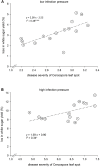New Generation of Resistant Sugar Beet Varieties for Advanced Integrated Management of Cercospora Leaf Spot in Central Europe
- PMID: 29535743
- PMCID: PMC5835311
- DOI: 10.3389/fpls.2018.00222
New Generation of Resistant Sugar Beet Varieties for Advanced Integrated Management of Cercospora Leaf Spot in Central Europe
Abstract
Cercospora leaf spot (CLS) epidemics in sugar beet have been increasing in recent years causing higher use of fungicides. Concomitantly, the availability of effective fungicides is at risk because of resistance development in the fungus, the lack of new active ingredients as well as restrictive approval practices. A key option for an integrated management of CLS is cultivation of resistant varieties. Because of the yield penalty in resistant varieties, acceptance in commercial practice so far has been low. The aim of our study was to characterize recent sugar beet varieties registered in Germany in terms of resistance and tolerance to CLS and their value for integrated pest management. The genetic basis of CLS resistance in varieties is protected by intellectual property rights even after variety registration and not open to the public due to economic competition. To gain reliable data for cultivation, varieties have to be tested for their resistance traits under field conditions at varying levels of infection with Cercospora beticola. In collaboration with variety related stakeholders, 15 sugar beet varieties were tested in 49 field trials in Germany from 2014 to 2016 for their yield response to CLS. The trials were set up in a split-plot design with and without infection (i.e., with and without fungicide). The classification of varietal reaction to CLS is based on symptomatic leaf area (susceptibility) and the resulting relative yield loss (tolerance). Since the relation between both parameters varied among varieties, it was used as an additional parameter to describe tolerance. On this basis, three groups of varieties were identified. They can be characterized as a susceptible, a resistant and a presumably tolerant cluster. A comparison of the data with an older dataset originating from 2009 to 2011 revealed that yield performance of recent varieties with resistance to C. beticola caught up with susceptible varieties due to breeding progress. They showed no yield penalty in the absence of the disease and better economic performance than susceptible varieties. It is assumed that these varieties will allow a substantial reduction of fungicide use for an advanced integrated pest management under central European conditions.
Keywords: Cercospora beticola; breeding progress; economic performance; resistance; sugar beet; sugar beet yield; variety trials; yield penalty.
Figures






Similar articles
-
Genomic characterization of bZIP gene family and patterns of gene regulation on Cercospora beticola Sacc resistance in sugar beet (Beta vulgaris L.).Front Genet. 2024 Jul 30;15:1430589. doi: 10.3389/fgene.2024.1430589. eCollection 2024. Front Genet. 2024. PMID: 39139817 Free PMC article.
-
Effect of sugar beet variety resistance on the disease epidemiology of Cercospora beticola.Pest Manag Sci. 2025 Jun;81(6):2970-2980. doi: 10.1002/ps.8666. Epub 2025 Jan 23. Pest Manag Sci. 2025. PMID: 39846265 Free PMC article.
-
Rapid Detection of Cercospora beticola in Sugar Beet and Mutations Associated with Fungicide Resistance Using LAMP or Probe-Based qPCR.Plant Dis. 2020 Jun;104(6):1654-1661. doi: 10.1094/PDIS-09-19-2023-RE. Epub 2020 Apr 13. Plant Dis. 2020. PMID: 32282278
-
Cercospora leaf spot disease of sugar beet.Plant Signal Behav. 2023 Dec 31;18(1):2214765. doi: 10.1080/15592324.2023.2214765. Plant Signal Behav. 2023. PMID: 37209061 Free PMC article. Review.
-
Salt and drought stress-mitigating approaches in sugar beet (Beta vulgaris L.) to improve its performance and yield.Planta. 2023 Jun 26;258(2):30. doi: 10.1007/s00425-023-04189-x. Planta. 2023. PMID: 37358618 Review.
Cited by
-
Cercospora beticola: The intoxicating lifestyle of the leaf spot pathogen of sugar beet.Mol Plant Pathol. 2020 Aug;21(8):1020-1041. doi: 10.1111/mpp.12962. Mol Plant Pathol. 2020. PMID: 32681599 Free PMC article.
-
Evaluating Rhizobacterial Antagonists for Controlling Cercospora beticola and Promoting Growth in Beta vulgaris.Microorganisms. 2024 Mar 27;12(4):668. doi: 10.3390/microorganisms12040668. Microorganisms. 2024. PMID: 38674613 Free PMC article.
-
Genomic characterization of bZIP gene family and patterns of gene regulation on Cercospora beticola Sacc resistance in sugar beet (Beta vulgaris L.).Front Genet. 2024 Jul 30;15:1430589. doi: 10.3389/fgene.2024.1430589. eCollection 2024. Front Genet. 2024. PMID: 39139817 Free PMC article.
-
Bacterial endophytes as indicators of susceptibility to Cercospora Leaf Spot (CLS) disease in Beta vulgaris L.Sci Rep. 2022 Jun 23;12(1):10719. doi: 10.1038/s41598-022-14769-8. Sci Rep. 2022. PMID: 35739218 Free PMC article.
-
Effect of sugar beet variety resistance on the disease epidemiology of Cercospora beticola.Pest Manag Sci. 2025 Jun;81(6):2970-2980. doi: 10.1002/ps.8666. Epub 2025 Jan 23. Pest Manag Sci. 2025. PMID: 39846265 Free PMC article.
References
-
- Agrios G. N. (2005). Plant Pathology 4th Edn. London: Elsevier.
-
- BISZ (2017). Beratung und Information für den Süddeutschen Zuckerrübenanbau. Allgemeine Sortenbeschreibung. Available at: https://bisz.suedzucker.de/sorten/allgemeine-sortenbeschreibung/ [accessed October 24, 2017].
-
- Brendler F., Holtschulte B., Rieckmann W. (2008). Zuckerrübe. Krankheiten, Schädlinge, Unkräuter 2nd Edn. Bonn: AgroConcept.
-
- BSA (2000). Bundessortenamt. Richtlinien für die Durchführung von Landwirtschaftlichen Wertprüfungen und Sortenversuchen. Hanover: Landbuch Verlag; Available at: http://www.bundessortenamt.de/internet30/fileadmin/Files/PDF/Richtlinie_... (verified 18 December 2017).
LinkOut - more resources
Full Text Sources
Other Literature Sources

